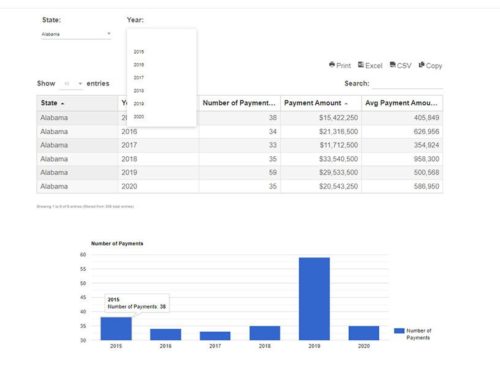
As a medical malpractice insurance broker, my priority is to secure optimal coverage for my physician clients – strength of coverage and price are important. In this article, we’ll review the reasons behind the anticipated rate hikes in 2025 and explore the most effective strategies doctors can employ to mitigate these escalating costs.
Table of Contents
Are Malpractice Insurance Premiums Going up in 2025?
Over the last decade, malpractice insurance premiums have steadily increased, and 2025 will see the highest rates in recent years. While this trend has become foreseeable, the current financial burden is significantly affecting physicians, directly shaping their decision-making processes and impacting the quality of healthcare nationwide.
What Influences the Premiums You Pay?
There are a variety of factors that play into higher malpractice insurance premiums for physicians and surgeons.
- Surgical Specialties
Surgery carries substantial risks, particularly in higher-risk specialties such as Orthopedic, Bariatric, General, Neurological, and Obstetrics and Gynecology, which are prone to higher claim volumes. This requires them to carry strong coverage at a higher premium cost. Given the escalating legal defense expenses and substantial verdicts in recent times, increased payouts by carriers are leading to higher rate increases.
- Types of Coverage
Neurosurgeons, bariatric surgeons, orthopedic surgeons, OB/GYNs, plastic surgeons, and urologists rank among the top 10 medical specialists facing lawsuits. Consequently, the risks they face are more expensive to insure, thus the correspondingly higher premium costs for both Occurrence and Claims-made coverage.
There are two types of coverage that physicians and surgeons can opt for: Occurrence Form Coverage and Claims-Made Coverage.
-
- Occurrence Form Coverage is favored since it doesn’t require tail coverage in the future. It offers straightforward and long-lasting protection for medical professionals by covering incidents that occur during the policy period regardless of when the claim is filed. Furthermore, the cost of occurrence coverage remains relatively level through the years. Occurrence coverage might not be available depending on the risk profile. Occurrence coverage is more expensive starting out, but there is no future cost of tail coverage to worry about.
- Claims-Made Coverage, the most common form of malpractice insurance, covers claims made and reported during the policy period. It typically starts with lower premiums compared to Occurrence Form Coverage but increases annually for the first five years, reflecting the increasing risk of claims being made over time. Additionally, the need for tail coverage adds an extra cost (usually another 200-300% of the expiring premium in most cases) when coverage needs to change due to new jobs, retirement, cancellation or non-renewal of coverage, etc.
- Number of Claims & Their Outcomes
The type of coverage you choose, the number of claims you have, and their outcomes, and even the size and location of your practice all factor into the premiums you pay.
Trends Indicate Rising Premiums for 2025
Medical liability premiums have been going up consistently for the past decade, and show no signs of slowing. In 2019 the year-to-year premium increase percentage nearly doubled, escalating from 13.7% in 2018 to 26.5%. Premiums experienced another rise in 2022, with 36.2% witnessing an increase. Major factors driving these hikes encompass substantial claims resulting in larger payouts, escalating legal fees, and economic inflation.
1. Severity of Claims with Larger Payouts
Despite Illinois seeing the highest increase in premiums in 2021, a report from Illinois Courts showed a 43% drop in malpractice claims. Similarly, Medscape’s Malpractice Report 2021 highlighted a significant decrease in malpractice lawsuits across the country during 2020 and 2021.
So, why did malpractice insurance premiums increase during this timeframe?
The severity of the filed claims and the resulting higher financial settlements for plaintiffs were the key factors. A June 2022 article from Medscape Medical News noted insurers’ concern over the increasing occurrence of “record-high verdicts” in U.S. malpractice cases. While not all claims lead to such significant payouts, even a few can affect premium costs.
| State | Medical Liability Increase | Contributing Factors |
|---|---|---|
| Illinois | 63.6% | Experiences around 1,600 lawsuits annually with an average payout of slightly over $200,000. |
| New Mexico | 33% | From 1990 to 2020, the average payout is $105,000 per case. |
| Oregon | 26.7% | Recently ranked among the least favorable states for physicians due to limited opportunities and challenging medical environments. |
| Kansas | 20% | In 2022, Dr. Kelli Sandri faced a major judgment for medical negligence, resulting in a record $25.4 million awarded to the plaintiff. This verdict is considered the largest in the Kansas City Metropolitan Area and nearby counties. |
| South Dakota | 20% | Despite low numbers of medical malpractice suits filed between 1990 and 2020, the average payout of cases over 30 years has had substantial payouts of $94,000. |
| Kentucky | 20% | The frequency of malpractice suits and the average $70,000 payouts directly influence insurance rates. |
2. Rising Cost of Legal Fees
Malpractice insurance carriers typically retain and pay the expenses of legal representation for the physician or policyholder involved in a lawsuit. Legal defense expenditures are considerable for malpractice lawsuits ranging from $50,000 to $100,000 on average, with even higher fees– sometimes up to 40% for prolonged and intricate cases. Although some states have capped the fees lawyers can receive with tort reform efforts, there are a host of other payouts that carriers must endure including:
-
- Expert witness fees
- Attorney travel expenses
- Copying costs
- Court filing costs
This financial burden on insurance carriers serves as a fundamental factor contributing to premium hikes.
3. Economic Inflation
The overall condition of the U.S. economy has a profound effect on malpractice litigation costs, leading to notable impacts on insurance premiums. According to data from the Bureau of Labor Statistics, consumer prices surged by 9.1% from June 2021 to June 2022, representing the most substantial increase in forty years.
This surge in essential living expenses, including food, electricity, and fuel, prompts plaintiff attorneys in malpractice cases to pursue higher financial compensation for their clients. Consequently, malpractice insurance carriers face increased payouts in cases where policyholders are unsuccessful.
How Can Physicians & Surgeons Mitigate Rising Premium Rates?
Reducing malpractice risk can potentially reduce costs.
What Does This Mean?
It’s important to note that malpractice insurance carriers often increase premiums annually, considering factors like those discussed here, to maintain the financial stability of their insurance pool. While rate hikes may seem unwelcome, they are preferable to carrier insolvency, a situation that has left many doctors without proper protection when companies like Capson, Galen, and Oceanus became insolvent.
Increasing premiums universally (for all insureds) as well as a standard approach for carriers to guard against unforeseen substantial losses and maintain coverage for all policyholders. However, the best strategy to potentially avoid significant premium increases is to prevent medical malpractice lawsuits altogether.
Here are three ways you can reduce your risk of malpractice suits and potentially keep escalating premium renewal costs in check:
1. Transparency & Consistency
Take proactive steps to improve communication with patients. Keep precise records of all patient appointments, calls, and conversations throughout treatment and post-care.
2. Get it in Writing & Informed Consent
Ensure that your patients fully understand any possible complications of a surgical procedure and give their informed consent.
3. Stay Current & Strive for Excellence… Always
Raise the level of surgical excellence in your practice with physicians who are board-certified and have fellowship-trained skills and experience in their specialty. Then, partner with a trusted medical malpractice broker who is familiar with your specialty and can match you with the right coverage from an AM Best A-rated carrier.
Take the Next Steps
Need coverage now? MEDPLI medical malpractice insurance brokers can help you find the right coverage from top carriers – at the best rates. Call us at 1-800-969-1339 to protect your practice or email us at info@medpli.com.



